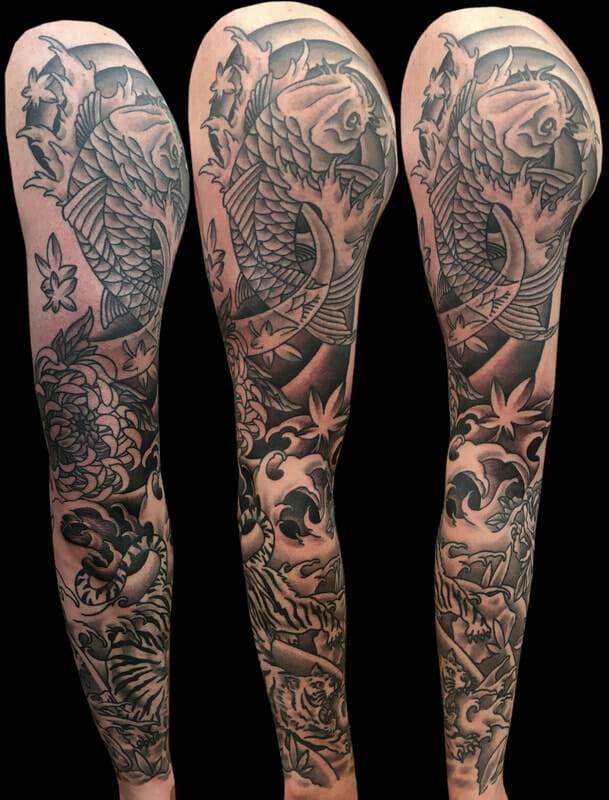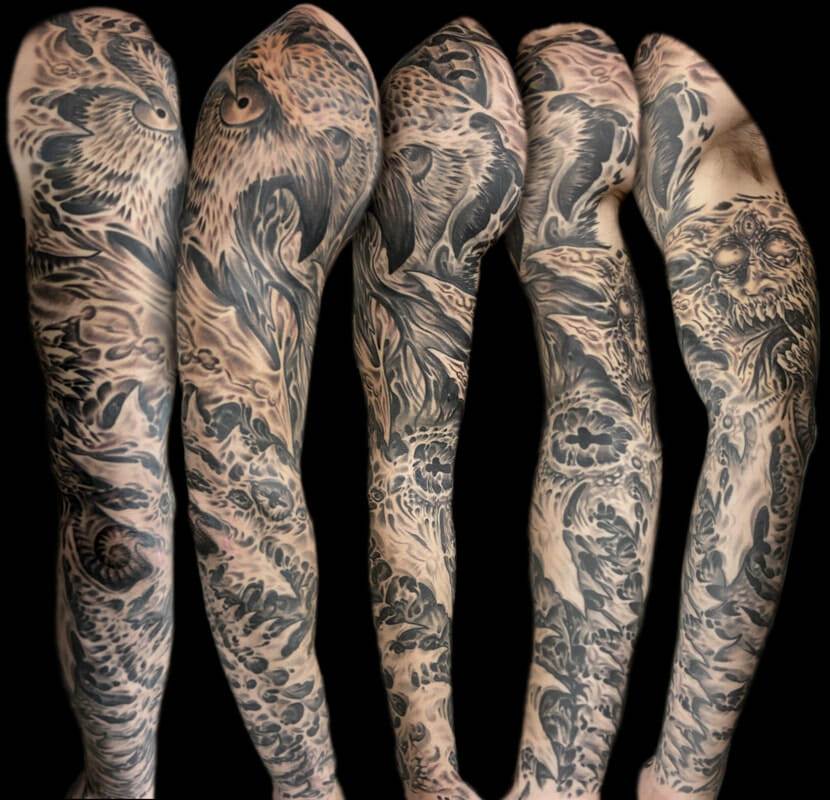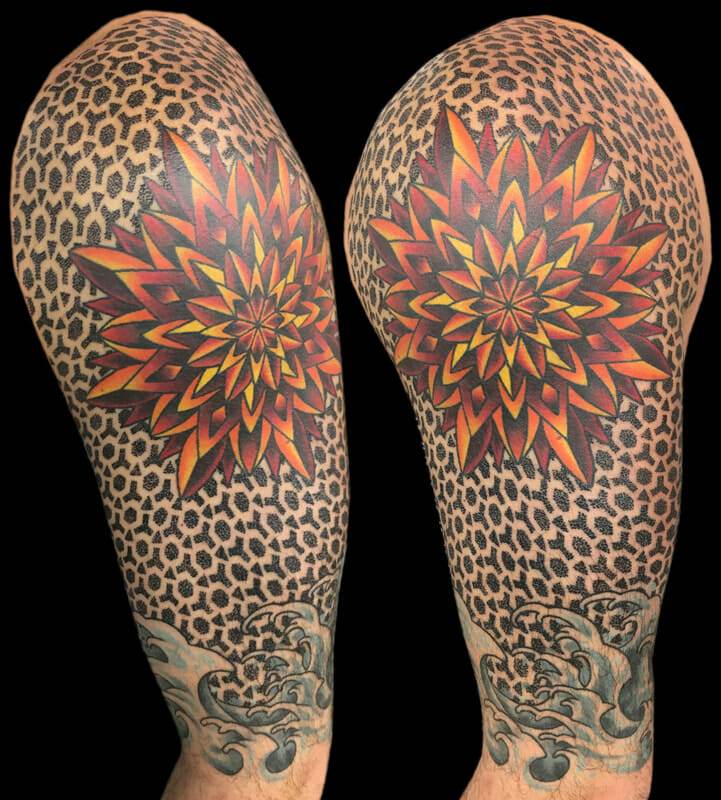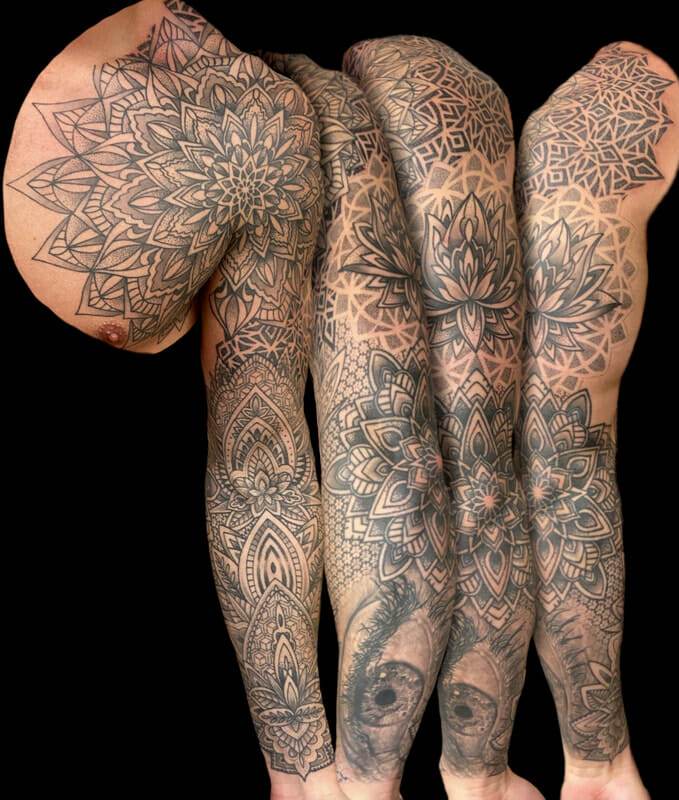Biomechanical tattoos are a unique and captivating form of body art that combines elements of machinery, robotics, and organic forms. These tattoos often depict intricate designs that give the illusion of mechanical parts integrated into the human body. The term “biomechanical” refers to the fusion of biology and mechanics, creating a visually striking and thought-provoking aesthetic.
The history of biomechanical tattoos can be traced back to the late 1970s and early 1980s when Swiss artist H.R. Giger popularized this style through his artwork. Giger, known for his dark and surrealistic imagery, created a series of paintings that featured biomechanical elements. These paintings later inspired tattoo artists to recreate his designs on the skin, giving birth to the biomechanical tattoo movement.
The History of Biomechanical Tattoos: From H.R. Giger to Today
H.R. Giger’s influence on biomechanical tattoos cannot be overstated. His unique blend of organic and mechanical forms captured the imagination of many artists and tattoo enthusiasts. Giger’s most famous creation, the Xenomorph from the “Alien” franchise, showcased his mastery of biomechanical design.
Over time, biomechanical tattoos have evolved and become more intricate and detailed. Tattoo artists have pushed the boundaries of what is possible with this style, incorporating elements such as gears, pistons, wires, and circuitry into their designs. The use of shading and color has also become more refined, adding depth and dimension to these tattoos.
The Fusion of Technology and Creativity: How Biomechanical Tattoos Are Made
Creating a biomechanical tattoo requires a combination of artistic skill and technical expertise. Tattoo artists use various techniques to bring these designs to life on the skin. One common technique is freehand drawing, where the artist uses a tattoo machine to create the design directly on the client’s body. This allows for a more organic and fluid design that follows the contours of the body.
Another technique used in biomechanical tattooing is stencil transfer. The artist creates a stencil of the design and applies it to the skin before tattooing. This method ensures precision and accuracy, especially for complex and intricate designs.
Technology also plays a significant role in biomechanical tattoo design. Many artists use computer software to create digital mock-ups of their designs before transferring them onto the skin. This allows for greater experimentation and refinement of the design, ensuring that it meets the client’s expectations.
The Popularity of Biomechanical Tattoos: Why Are People Drawn to Them?
There are several reasons why people choose biomechanical tattoos. One reason is the aesthetic appeal of these designs. The combination of organic and mechanical elements creates a visually striking contrast that captures attention. Biomechanical tattoos often stand out from other tattoo styles, making them a popular choice for those who want something unique and eye-catching.
Another reason for the popularity of biomechanical tattoos is their association with strength and resilience. The mechanical components in these designs symbolize power and durability, while the organic elements represent life and vitality. For some, getting a biomechanical tattoo is a way to express their inner strength and resilience in the face of adversity.
Biomechanical tattoos also have cultural significance in certain communities. In some cultures, these tattoos are associated with futuristic themes and technological advancements. They may symbolize a fascination with science fiction or a desire to embrace the possibilities of technology.
The Meaning Behind Biomechanical Tattoos: Symbolism and Significance

Biomechanical tattoos can hold different meanings for different people. On a symbolic level, these tattoos often represent the merging of man and machine, blurring the boundaries between the natural and the artificial. They can symbolize the integration of technology into our lives and the potential for human enhancement through science and innovation.
For some, biomechanical tattoos may also represent a fascination with the inner workings of the human body. These tattoos can be seen as a way to explore the complexities of our anatomy and the interconnectedness of our biological systems.
On a personal level, biomechanical tattoos can hold deeply meaningful significance. They may represent a personal journey or transformation, symbolizing the overcoming of obstacles or the embracing of change. These tattoos can also serve as a reminder of one’s own strength and resilience in the face of adversity.
Biomechanical Tattoos in Popular Culture: From Movies to Music
Biomechanical tattoos have made their mark in popular culture, appearing in movies, music videos, and other forms of media. One notable example is the “Alien” franchise, which features H.R. Giger’s iconic biomechanical designs. The Xenomorph, with its sleek and otherworldly appearance, has become an iconic symbol in science fiction.
In the world of music, biomechanical tattoos have been embraced by various artists and bands. Musicians such as Trent Reznor of Nine Inch Nails and Maynard James Keenan of Tool have sported biomechanical tattoos, incorporating them into their stage personas and album artwork. These tattoos add to the overall aesthetic and visual storytelling of their music.
The Future of Biomechanical Tattoos: Advancements in Technology and Design
As technology continues to advance, so too will the possibilities for biomechanical tattoo design. New techniques and tools are constantly being developed to push the boundaries of what is possible with this style.
One area of advancement is in the use of 3D printing technology. Some tattoo artists are experimenting with creating custom-made prosthetics and attachments that can be integrated into biomechanical tattoo designs. This allows for a more interactive and immersive experience, blurring the lines between the tattoo and the body.
Advancements in digital design software also offer new possibilities for biomechanical tattoos. Artists can now create highly detailed and realistic designs that were once only possible in the realm of imagination. These advancements allow for greater creativity and innovation in the field of biomechanical tattooing.
Famous Biomechanical Tattoo Artists: Profiles and Portfolios
Several tattoo artists have gained recognition for their expertise in biomechanical tattooing. One such artist is Guy Aitchison, known for his intricate and detailed designs. Aitchison’s work often features a combination of organic and mechanical elements, creating a sense of movement and flow.
Another renowned artist in the field is Paul Booth, whose dark and macabre style has made him a favorite among fans of biomechanical tattoos. Booth’s designs often incorporate elements of horror and the occult, adding an extra layer of depth and symbolism to his work.
Tips for Getting a Biomechanical Tattoo: What to Consider Before Getting Inked
Before getting a biomechanical tattoo, there are several factors to consider. First and foremost, it is essential to choose a reputable tattoo artist who specializes in this style. Look at their portfolio to ensure that their work aligns with your vision and expectations.
It is also important to think about the placement of the tattoo. Biomechanical tattoos often require a larger canvas due to their intricate nature. Consider which part of your body will best showcase the design and allow for the level of detail you desire.
Lastly, take the time to think about the meaning behind the tattoo. Biomechanical tattoos can be deeply personal, so it is important to choose a design that resonates with you on a symbolic level. Consider what message or story you want your tattoo to convey.
Biomechanical Tattoos and Body Modification: The Intersection of Art and Science
Biomechanical tattoos are a prime example of the intersection between art and science. These tattoos combine artistic creativity with an understanding of human anatomy and mechanics. Tattoo artists who specialize in biomechanical design often have a deep knowledge of both art and science, allowing them to create designs that are visually stunning and technically accurate.
The role of science in biomechanical tattoo design goes beyond just the aesthetics. Tattoo artists must understand the mechanics of the human body to create designs that appear realistic and believable. They must consider factors such as muscle movement, joint articulation, and the overall structure of the body when designing biomechanical tattoos.

The Enduring Appeal of Biomechanical Tattoos
Biomechanical tattoos continue to captivate and intrigue people around the world. Their unique blend of organic and mechanical elements creates a visually striking aesthetic that stands out from other tattoo styles. The symbolism and personal significance behind these tattoos make them a popular choice for those seeking a meaningful and visually appealing form of self-expression.
As technology continues to advance, the possibilities for biomechanical tattoo design will only continue to grow. New techniques and tools will allow for greater creativity and innovation in this field, pushing the boundaries of what is possible with this style.
Whether it is the allure of the futuristic themes, the fascination with the inner workings of the human body, or simply the aesthetic appeal, biomechanical tattoos have a lasting appeal that will continue to captivate tattoo enthusiasts for years to come.



